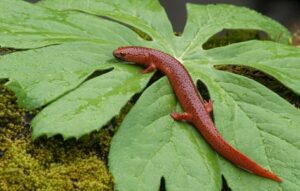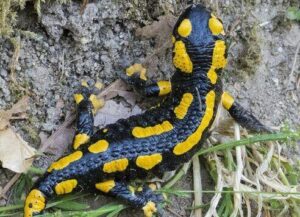Salamanders are quiet, secretive creatures that often go unseen in the forests and wetlands where they live. But now and then, one stands out. Bright orange and boldly colored, it walks slowly across a damp forest trail. Its color draws attention. Many people wonder the same thing: are orange salamanders poisonous?
Yes, some orange salamanders, like the red eft and red salamander, are mildly poisonous. They use their bright coloring to warn predators, and they release toxins through their skin that can cause irritation if touched or swallowed.
These salamanders are not deadly to people, but they should still be handled with care. Their colors are nature’s warning signs, and their poisons help them survive in a world full of hungry predators.
What Species of Salamanders Are Orange?
The most commonly seen orange salamander in North America is the red eft. This is the land-dwelling juvenile stage of the Eastern newt, a species found in forests and wetlands across the eastern United States and Canada.

Red efts are about 2 to 3 inches long and are bright orange with tiny black spots. Their skin feels dry and slightly rough, unlike the slimy feel of adult newts.
However, red efts are not the only orange salamanders. A few other species either have orange skin or show orange markings on their bodies.
Some of the best-known include:
- Red Salamander (Pseudotriton ruber): A large, reddish-orange salamander with dark spots. Found in cool streams and seepages. These salamanders are mildly poisonous.

- Spotted Salamander (Ambystoma maculatum): Usually dark with bright yellow or orange spots along its back. These salamanders are mildly poisonous.

- Eastern Newt (Notophthalmus viridescens): The adult is olive green with small orange spots, but the juvenile eft is completely orange and has strong skin secretions.

- Fire Salamander (Salamandra salamandra): Found in Europe, not North America. It has black skin with bright orange or yellow patches. These salamanders are highly poisonous.

These colors are not random. They serve a purpose in nature, and they send a clear message to other animals: stay away.
Why Are Orange Salamanders Brightly Colored?
In the wild, color can be more than just decoration. Bright skin can act as a warning, telling predators that an animal is toxic or dangerous. This type of warning signal is called aposematic coloration.
Orange and red are especially effective warning colors. Many predators learn quickly that animals with these colors taste bad or make them sick.
Once a predator has a bad experience, it often avoids anything with a similar color in the future.
For salamanders, this kind of warning system works well. It keeps them safe without needing to run fast, fight back, or hide all the time.
How Do These Salamanders Use Their Poison?
Unlike venomous animals like snakes or spiders, salamanders don’t bite or sting to deliver their poison. Instead, they release toxins through their skin. These toxins come from small glands and sit on the surface of the salamander’s body.
When a predator picks one up or tries to bite it, the toxin gets into the predator’s mouth or onto its skin. The result is usually an unpleasant taste, mild numbness, or irritation
In some cases, the predator may feel sick or even vomit. Most learn not to make the same mistake again.
The poison is not meant to kill. It is meant to teach a lesson. And for many predators, one taste is enough.
Are Orange Salamanders Dangerous to Humans?
For people, the risk is low. The toxins in these salamanders are mild and usually cause only slight skin or eye irritation if touched.
In rare cases, people may feel a tingling sensation or minor numbness if the toxin gets into the eyes or mouth.
However, it’s always best to be cautious. If you touch an orange salamander, be sure to:
- Wash your hands afterward
- Avoid rubbing your eyes or touching your mouth
- Keep children and pets from handling them
These simple steps are enough to stay safe. The poison in orange salamanders is not deadly to humans, but good hygiene is still important.
What Toxins Do Orange Salamanders Produce?
Some orange salamanders, especially the red eft, produce a chemical called tetrodotoxin. This is a strong neurotoxin also found in animals like pufferfish and blue-ringed octopuses.
In those animals, the toxin is deadly. In salamanders, the dose is much smaller.
Tetrodotoxin blocks nerve signals, which can cause numbness or paralysis. But red efts and similar salamanders don’t produce enough of it to seriously harm people.
The toxin is only dangerous in large amounts or if ingested directly.
Other species produce bitter-tasting or irritating compounds that discourage predators without affecting the nervous system.
These chemicals vary from one species to another, but they all serve the same purpose: keeping the salamander from being eaten.
Is It Safe to Touch an Orange Salamander?
Yes, but it must be done carefully.
If you need to move one off a trail or help it avoid danger, you can do so with wet hands or a damp leaf. Dry hands can damage its skin, which is very sensitive and helps it breathe.
After touching one, always wash your hands thoroughly. Do not touch your face, mouth, or eyes until you do. Even mild toxins can cause irritation in sensitive areas.
Never let pets or children play with salamanders. Their small bodies and delicate skin can be easily harmed. And the toxins, while not deadly, are not meant to be swallowed.
Do All Brightly Colored Salamanders Have Toxins?
Most do, but not all. Some harmless salamanders copy the colors of toxic species. This is called Batesian mimicry, and it’s a common survival tactic in nature.
By looking like a poisonous species, a harmless salamander can avoid being eaten. Predators see the bright color and remember a bad experience. They don’t know the difference.
For safety, it’s best to treat all brightly colored salamanders as if they are mildly toxic. That protects you, and it protects the salamander too.
Can These Salamanders Harm Other Animals?
Yes, to a small degree.
When predators try to eat an orange salamander, they often get sick. A bird might gag or foam at the beak. A snake might shake its head or stop hunting. These reactions don’t last long, but they make a lasting impression.
Predators learn quickly. In areas where toxic salamanders are common, local animals usually leave them alone. That’s the power of warning coloration and mild poison.
Why Are Orange Salamanders So Bold?
Most small animals try to stay hidden. But orange salamanders often move slowly and openly, even in daylight. Their color does the work of protecting them.
Because they taste bad or make predators feel sick, they don’t need to run or hide as much. Their color sends a clear message: I am not a good meal.
This strategy has worked for millions of years. Evolution has shaped them into confident walkers on the forest floor.
Where Can You Find Orange Salamanders?
Orange salamanders like the red eft are found in forests across eastern North America. They prefer moist, shaded areas with plenty of leaf litter, logs, and moss.
- Red salamanders live near cold, clear streams or seepages. They are harder to spot but may appear after rain.
- Spotted salamanders live underground most of the year. They come out during spring rains to breed in vernal pools.
- Fire salamanders live in Europe and are not native to North America. They prefer cool, wet forests and are also toxic to predators.
What Should You Do If You Find One?
If you see an orange salamander, enjoy the moment. Watch it walk. Take a picture if you like. But try not to touch it unless necessary.
If it’s on a path, gently move it out of danger using wet hands or a leaf. Do not pick it up just to hold it. And never take one home.
Salamanders are an important part of the forest. They eat insects, aerate soil, and serve as food for other wildlife. Leaving them in place helps keep nature balanced.
Do Other Amphibians Use Color as a Warning?
Yes. Bright colors are common among poisonous amphibians.
- Poison dart frogs in South America use neon skin to warn of deadly toxins.
- Some toads have colorful glands that release bitter chemicals.
- Bright-skinned salamanders rely on the same message: Don’t touch.
Nature has a clear code. When an animal is small but bright, it often means “stay away.”
Conclusion
So, are orange salamanders poisonous?
Yes, many orange salamanders like the red eft and red salamander release mild toxins through their skin.
These toxins are not deadly to humans but can cause irritation or discomfort if touched or ingested.
Their bright colors are a warning. They help the salamander survive by making predators think twice. While it is safe to observe them, it’s best not to handle them unless necessary, and always with care.
These bold little amphibians are more than just pretty faces. They are part of a larger system that keeps forests healthy and ecosystems balanced.
Hi, my name is Ezra Mushala, i have been interested animals all my life. I am the main author and editor here at snakeinformer.com.

